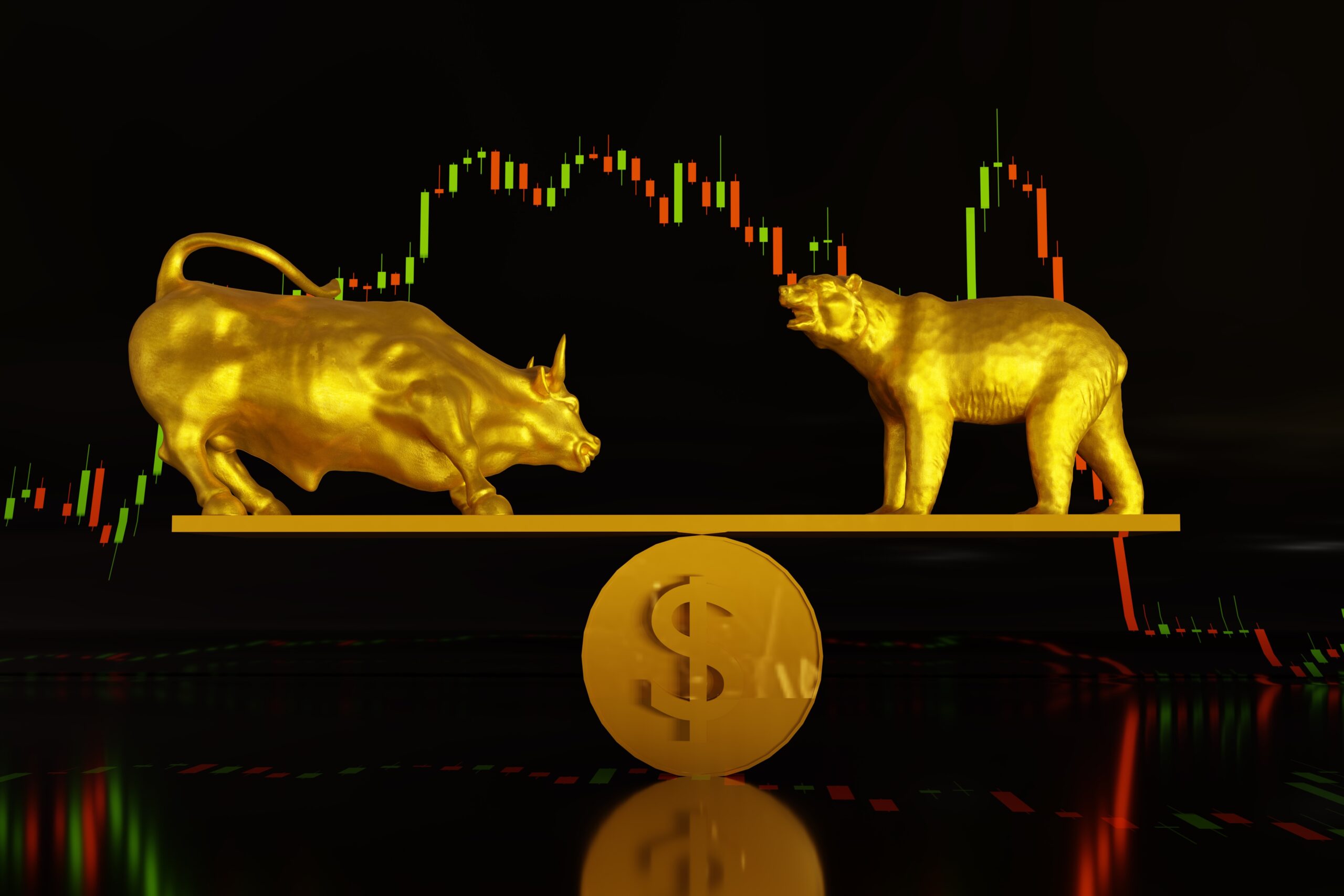
- Financial Insights
- Market Insights
Focus on What is Important
Gary Dugan, Chadi Farah, Bill O'Neill
The Global CIO Office
- The dip in equity volatility likely suggests investors are getting used to the unpredictability of US government policy making
- Through the noise of US policymaking, it’s important to focus on key macro aspects of growth, inflation, and the dollar
- US growth is under some pressure, consensus GDP forecasts are on the slide but average around 2.0% for 2025
- Current inflation data has been OK, but US households in particular see trouble ahead
- President Trump, if he listens to some of his advisors, could try to weaken the dollar
- Investors should be geographically diversified and hold gold
- It could be time for some coffee as we wonder if Starbucks is better than Nvidia
Are Getting Used to the Noise? – Sort of
Markets adjust to any uncertainty over time. When President Trump took office in January, expectations ran high that his second stint at the White House will be characteristically different. Indeed, as the president embarked on an aggressive policy posturing, even his supporters were often caught off guard by the unpredictability of his actions—whether it was about dismantling previous policies or challenging constitutional norms. Yet, markets learnt to adapt.
If Trump announces yet more tariffs this week, the market reaction will likely be more muted than in the past, as investors have grown accustomed to his unpredictable stance on policymaking. This resilience helps explain why the volatility in the broader S&P 500 has eased recently, even as the index fell another 2.3% last week. Notably, on Friday, the S&P 500 posted its best day since the election. Meanwhile, the VIX index, a measure of market volatility, declined to 21.8 on Friday from 27.9 on 10 March.
Chart 1: VIX Index of S&P 500 Volatility

Source: Bloomberg
Focus on What’s Important
With so much confusion in the markets it’s easy to lose way even as a myriad of topics seemingly drive investor sentiments. From tariffs, immigration, and DoJ speeches to the situation in Ukraine, Yemen, and Gaza, none of us can predict the outcomes for all of these events with distinct precision. It is therefore better to focus on an outcome that has a more direct bearing on the markets – and, in this case, we would point to three: growth, inflation, and the dollar.
Growth: According to Bloomberg, the consensus expectation is for 2.2% growth in 2025, although quite a few of the economists polled have trimmed their forecasts to numbers at or below 2%. Recent examples include:
- Goldman Sachs, which reduced its 2025 GDP growth forecast to 1.7% from 2.4% earlier, citing the adverse effects of increased tariffs on imports from Canada, Mexico, and China.
- Vanguard, projects a 1.4% GDP growth for 2025, acknowledging downside risks due to tightening financial conditions and emerging weaknesses in the labour market.
- Congressional Budget Office (CBO), anticipates a slowdown in economic growth, forecasting a decrease in growth to 1.9% in 2025 from an estimated 2.3% in 2024, with growth retreating further to 1.8% in 2026.
- Deloitte, expects real GDP to grow 1% in 2025, supported by resilient consumer spending, partly because of anticipated increases in the minimum wage.
Inflation: A Temporary Calm or a Looming Storm?
So far, inflation has remained relatively well-behaved—but risks to the upside persist. The latest data suggests inflation trended slightly lower than expectations in February. While the decline isn’t dramatic, it has provided some comfort to the markets. Notably, bond market volatility remains below long-term averages.
However, market expectations for future inflation tell a different story. Since September, forward inflation pricing has surged, now sitting about a percentage point above the Fed’s comfort zone. The two-year breakeven inflation rate in the inflation-linked bond market has risen above 3%, signalling growing concerns.
Chart 2: Core PCE inflation Moving Closer to Fed’s Target

Source: Bloomberg
Surveys of industrial and consumer sentiments have shown a spike in expected inflation. The University of Michigan’s consumer confidence data released last week showed households anticipating a surge in inflation over the next 12 months. Just a few months back, households expected inflation to be around 2.6% in 2025. Given the current policy uncertainty and looming tariffs, that expectation has soared to 4.9%. Energy prices, which have been flat over the past few months, aren’t the culprit. Consumers see trouble from the unknown factor of tariffs.
Chart 3: University of Michigan Survey of Household Inflation Expectations for 1-year Inflation

Source: Bloomberg
The Dollar Under Trump 2.0: A Wild Card for Investors
One of the biggest unknowns for investors is how the Trump administration might approach the U.S. dollar. Historically, “Make America Great Again” has not always translated into “Make the Dollar Great Again.” Several of President Donald Trump’s former key economic advisors have previously supported policies aimed at weakening the dollar to enhance U.S. export competitiveness and address trade imbalances. If the past is any guide to the future, nothing can be ruled out.
Robert Lighthizer: As Trump’s former trade chief, Lighthizer has been a prominent proponent of dollar devaluation. He believes that an overvalued dollar contributes to trade deficits and hampers U.S. manufacturing. Reports indicate that Lighthizer and his team have explored strategies to weaken the dollar, including negotiating with foreign nations or implementing unilateral measures.
Stephen Miran: Nominated to chair the Council of Economic Advisers, Miran has expressed concerns about the strong dollar’s impact on trade deficits. He has proposed leveraging tariffs to bring countries to the negotiating table for currency realignment. Miran has also suggested restructuring U.S. debt by converting foreign-held Treasury securities into ultra-long-term bonds, aiming to alleviate immediate fiscal pressures and encourage a more favourable dollar valuation.
Peter Navarro: Serving as a trade advisor during Trump’s first term, Navarro has been a vocal critic of alleged currency manipulation by countries like China, Germany, and Japan. He argues that such practices disadvantage U.S. manufacturers and has advocated for policies to counteract these effects, including addressing currency misalignments.
Judy Shelton: A longtime critic of the Federal Reserve, Shelton has advocated for a return to the gold standard and has questioned the need for a central bank. Her views align with a preference for a weaker dollar to enhance U.S. competitiveness.
Sources: The independent, Politico, Atlantic Council, Bloomberg, Foreign Affairs
Collectively, these advisors support a strategic devaluation of the dollar as a tool to boost U.S. exports and reduce trade deficits. However, such policies carry significant risks—including higher inflation, rising import costs, and potential challenges to the dollar’s status as the world’s primary reserve currency.
If we put these arguments into today’s political language, Trump might view the sharp appreciation of the U.S. dollar index since 2009 as evidence that the rest of the world has been “ripping off” the United States. While the reality is far more complex, that may not deter him from pursuing policies that weaken the dollar.
In truth, the U.S. attracts capital to fund its massive deficits precisely because its domestic savings pool is insufficient. A deliberate push to devalue the dollar could disrupt this delicate balance—potentially triggering unintended economic consequences. Investors should watch this space closely.
Chart 4: US Dollar Index

Source: Bloomberg


